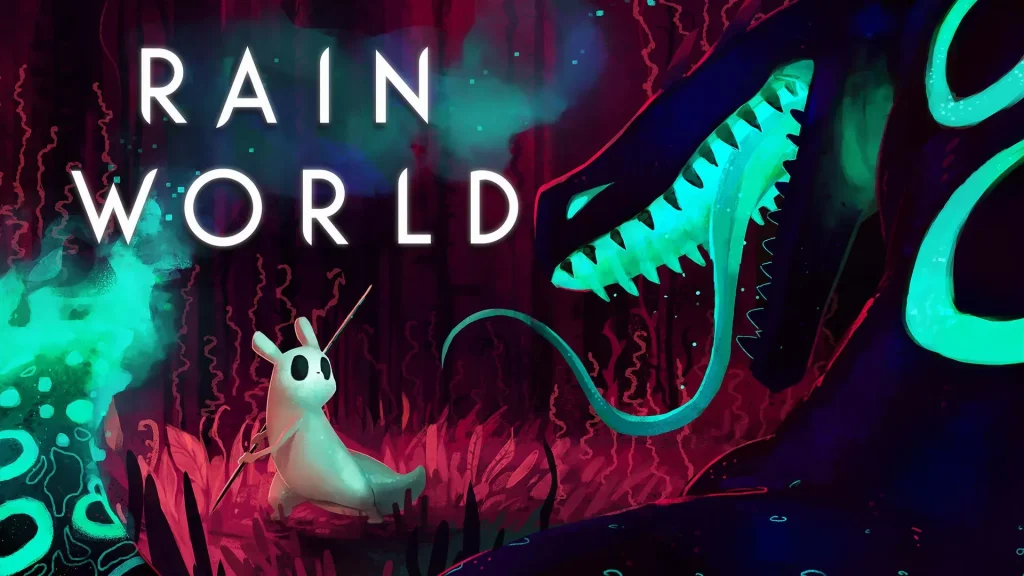Rain World plunges players into a rain soaked, perilous world where survival hinges on timing, exploration, and cunning. From the start you control a slugcat, and the slugcat mechanics emphasize stealth, precision, and memorable escapes, especially in back alley corridors and vertical chasms that reward timing. Its art style, jagged and fluid pixel animation, brings the wet, collapsing environment to life as you chase scarce food and safe nests across a world that reshapes itself with every rainstorm. To get the most out of the title, consult a Rain World guide that highlights safe routes and hibernation spots, plus community made maps and timing tactics gathered from patient players. While the game can be punishing, many players remember it through a Rain World review as a haunting, relentlessly inventive take on exploration and survival, a testament to perseverance and curiosity.
Viewed through an indie Metroidvania lens, this survival platformer places emphasis on exploration over traditional combat. Players guide a vulnerable slugcat through a waterlogged, post industrial landscape where environmental storytelling and predation shape your path. Gameplay loops hinge on nesting, hibernation, and careful resource management, with progression gated by a rhythm of risk and retreat. This approach has earned attention in retrospectives and guides that praise its atmosphere, challenge, and willingness to redefine what a survival adventure can feel like.
Rain World: Mastering Slugcat’s Movement through Walls and Pipes
Rain World’s slugcat moves with a tactile physics that rewards patience. Clinging to walls, threading through pipes, and tucking into narrow crevices are not just tricks but core survival tools in this world, a fact you can study in a Rain World guide.
Mastering these maneuvers demands practice and a willingness to read the environment. The Rain World tips many players share emphasize learning when to delay a leap, when to retreat, and how to use terrain to outpace threats. This is platforming with consequences that rewards thoughtful execution.
Survival and Karma: Navigating Rain World’s Perilous Ecosystem
Survival hinges on balancing hunger, energy, and karma as you roam a wet, labyrinthine world. Karma is lost on death, so planning routes around gates matters, a point you’ll see echoed in Rain World guide discussions.
A cautious approach that favors stealth over direct confrontation keeps you alive longer. In this world, fighting is often a last resort, and learning predator rhythms is part of the Rain World tips shared by the community.
From Hidden Nests to Hibernate: The Art of Safe Sleep in Rain World
Hibernate cycles are precious. Nest-building and rest stations let you replenish energy and reset your plans as you explore the ruins.
Stockpiling food while you shelter ensures you can endure the next stretch of exploration. The game rewards patience with safer spawns and reliable saves via hibernation.
Predator and Prey: Understanding Rain World’s Threats and Ambushes
Predators roam independently, wandering the map and often ignoring your struggles. Understanding their patterns helps you thread through screens more safely.
You often avoid combat by using speed, stealth, and clever positioning. The game’s threat design reinforces that you are prey as much as hunter, maintaining tension across the experience.
Environmental Storytelling in Rain World: Decoding Holograms and Dreams
Rain World’s storytelling comes through atmosphere: ruined habitats, glowing pipes, and holographic hints scattered across the map.
Slugcat dreams during hibernation offer cryptic backstory, and holograms provide hints about what happened here. This environment-driven storytelling invites players to infer meaning rather than seek direct direction, a focus discussed in Rain World review pieces and guides.
Progression and Gatekeeping: How Karma Gates Shape Rain World Exploration
Progression is gated by karma thresholds that determine access to new areas. This design forces risk management and detours, turning exploration into a puzzle where memory matters as much as reflexes.
Players map routes, locate safe havens, and learn where gates sit in the world. The gating system rewards careful traversal, a common theme in Rain World discussions about exploration.
Animations and Procedural Realism: The Rhythm of Rain World’s World Design
Rain World’s animations feel procedural, with movements that seem generated by rules rather than crafted frames. This creates a living world that responds with unpredictable beauty.
Coupled with constant rain, decaying ecosystems, and the lurking threats, the world has a rhythm that is at once oppressive and alluring, a trait fans highlight in Rain World reviews and discussions on its artistry.
Comparing Rain World to Hollow Knight: Different Takes on Metroidvania Survival
Compared to Hollow Knight, Rain World prioritizes survival, atmosphere, and learning through failure over straightforward combat.
Slugcat’s vulnerability and the emphasis on avoiding threats give the game a distinct tone that invites study, memorization, and improvisation—a Rain World experience that diverges from Hollow Knight’s approach.
Community Guide Reading: The Rain World Guide and Its Tips for New Players
The Rain World guide community offers routes, tips, and checklists to help newcomers avoid early frustration.
Rain World tips from players emphasize patience, scouting, and nest planning. Following these pointers can extend runs and reveal the game’s evolving rhythms.
Slugcat Behavior: Loops, Habits, and Mechanics Explained
Slugcat behavior blends hunger, curiosity, and instinct, forming loops that you learn by trying again and adjusting routes.
Understanding Slugcat mechanics—like energy management, stamina, and the balance between hiding and striking—helps you approach each screen with a plan and a toolkit for Rain World.
Rain World Review: What Critics Felt About Survival, Atmosphere, and Difficulty
Rain World as a reviewable experience earned praise for atmosphere, depth, and brutal challenge, while drawing critique for its steep learning curve and minimal handholding.
Critics often compare its mood and mechanics to indie titans, noting how the world invites persistence, curiosity, and endurance as central to the Rain World experience and the Rain World review discourse.
Rain World on Multiple Platforms: PC, PS4, and Beyond and the Game Pass Factor
Rain World released on PC and PS4, with later arrivals on other platforms and the potential for Game Pass availability, broadening its audience.
Updates and community patches keep the experience fresh, while guides and tips evolve with patches, helping players new and old navigate Rain World’s distinctive demands.
Frequently Asked Questions
Rain World guide: What are the essential first steps for mastering Rain World’s world and controls?
Start by learning slugcat’s movement—sliding, wall-slinking, and quick dashes. Prioritize locating a nest to hibernate and save, then stockpile food before resting. Explore gradually to map danger zones and understand how karma gates shape progression.
Rain World tips: What practical tips help you survive longer and progress in Rain World?
Balance exploration with rest: hibernate to replenish energy and recover karma. Collect food and keep nests stocked; avoid unnecessary fights when predators are near. Use stealth and environmental tricks to bypass threats rather than engage.
Slugcat mechanics: What core slugcat mechanics should new players learn in Rain World?
Master slinking along walls, pipe traversal, and nest-building to stay hidden. Manage stamina during long chases, use debris as limited weapons, and understand how hibernation saves progress. The balance between hunting and fleeing drives the survival loop.
Rain World review: How do critics describe the game’s difficulty, atmosphere, and storytelling in a Rain World review?
Reviews often highlight Rain World’s punishing pace, atmospheric world, and subtle storytelling through the environment. The game emphasizes survival over combat, with a steep learning curve that rewards patience and memory.
Rain World guide: How does the karma system work and why does it matter for progression?
Karma is lost on death and can be recovered by hibernating or eating specific flowers. You need sufficient karma to unlock areas and pass gates, guiding your route through the map. This design reinforces careful planning and exploration.
Rain World tips: What are the best strategies for avoiding predators and navigating Rain World’s dangerous environments?
Study predator patterns and plan routes that avoid direct confrontations. Use nests to rest and stash food, and lean on stealth rather than fighting when possible. Slow, deliberate movement helps you survive longer.
Rain World guide: Where can you find maps or resources to plan your Rain World route?
Look for environmental cues and holograms scattered across the map that hint at backstory and paths. As you explore, you’ll build a mental map of safe pockets, water, and karma gates. A good Rain World guide can help translate these clues into practical routes.
| Aspect | Key Points |
|---|---|
| Release and context | Rain World launched in early 2017 on PC and PS4; pre release hype included GIFs; noted as subtler than Hollow Knight. |
| Gameplay and traversal | Famous for its traversal: slugcat can slink up walls, slide through pipes, and navigate a jagged, waterlogged world with distinctive pixel art. |
| Combat and player approach | Combat is designed to be avoided; there is a predator vs prey dynamic. Survival generally takes precedence over fighting, with debris or spears used only when necessary. |
| Survival mechanics | Saving happens via hibernation; you need a decent stockpile of food to hibernate. Karma gates control progression, and karma is lost on death and recovered by hibernating or eating certain flowers. |
| Storytelling and world-building | The game uses environmental storytelling, slugcat dreams, holograms, and a guiding worm to reveal backstory, with minimal handholding. |
| World design and pacing | The world is labyrinthine and post industrial, with a hard going, slow rhythm. Animations are largely procedural, emphasizing player skill and memory. |
| Reception and platform availability | Praised for its unique vibe and challenge; often contrasted with Hollow Knight; later made available on Game Pass; roughly 3.5 GB in size. |
| Themes and tone | Rain World centers on survival as an underdog, with threats at every turn and a focus on flight over constant combat. |
| Impact and legacy | A standout indie Metroidvania survival title lauded for atmosphere, originality, and a challenging, memorable experience. |
Summary
Rain World stands out as an unforgiving survival platformer that tasks players with guiding a slugcat through a treacherous, waterlogged world. Its environmental storytelling, challenging pacing, and risk-versus-reward exploration place it among defining indie Metroidvania experiences. For fans and newcomers alike, Rain World offers a stark, memorable adventure that rewards patience, observation, and careful resource management.



